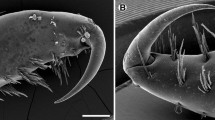Crustaceans seem eminently suitable for attachment to fishes. Their jointed limbs are sufficiently plastic in the evolutionary sense to produce formidable claws or pincer-like chelae with a vice-like grip. Nevertheless, moulting, a fundamental feature of crustacean biology, temporarily renders attachment by such limbs ineffective (see Chapter 8). During moulting the animal must slough off the whole of its exoskeleton, and this can only be achieved by relinquishing the grip of each limb temporarily, so that its old covering can be discarded. Moreover, the new exoskeleton enclosing each limb takes time to harden and until this has taken place secure attachment is compromised. Some copepod parasites have solved this problem by deploying a unique frontal filament or thread secreted by a frontal gland in the head. This filament is cemented at its free end to a stable structure in the host, such as a fin ray or basement membrane, while the other end is attached to the head of the parasite. Thus the parasite is securely tethered to the host during the dangerous process of moulting. The frontal filament has the added advantage that it is non-living and may be less provocative to the host’s immune system than living tissue. However, whether it is provocative or not, it is likely to be more resilient to host attack. This leads us to wonder why this remarkable and special attachment system has not been more widely adopted by fish parasites. One possible reason is that tethering severely reduces mobility and accessibility of food. Like a tethered horse, grazing is restricted to a circular area with a radius equal to the length of the tether. Reduction in mobility also reduces opportunities for meeting mates. Another problem is that the filament needs to be slender to permit the limited mobility that it provides. Stresses and strains on the filament will increase as parasites increase in size and the increase in filament thickness needed to prevent large parasites breaking free will further reduce mobility. So filament attachment is ideal for juvenile copepods that moult frequently, are small enough to satisfy their nutritional requirements from a relatively small area of host skin and place relatively weak strains on the filament.
Access this chapter
Tax calculation will be finalised at checkout
Purchases are for personal use only
Preview
Unable to display preview. Download preview PDF.
Similar content being viewed by others
Rights and permissions
Copyright information
© 2004 Springer
About this chapter
Cite this chapter
(2004). Siphonostomatoid copepods: (3) lernaeopodids. In: Leeches, Lice and Lampreys. Springer, Dordrecht. https://doi.org/10.1007/978-1-4020-2926-4_10
Download citation
DOI: https://doi.org/10.1007/978-1-4020-2926-4_10
Publisher Name: Springer, Dordrecht
Print ISBN: 978-1-4020-2925-7
Online ISBN: 978-1-4020-2926-4
eBook Packages: Springer Book Archive




